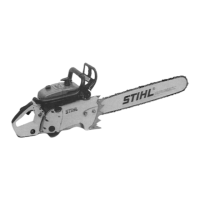_ '
To
8VoIcI
puShback
1.
Be
alert to forces or situations
that
may
cause
material
to
pinch the
top
of
the
chain.
2.
rlc?
notcut~reth~
one
log at a time. ' ,
3.
Do
not twist the •
when
withdrawing the
bar
from
a
plupge
cut
or
und8r~
cut (figures 25
to
'Zl
and
33,
pageS
16, 17 and 19),'
becaUse
the chain
can
pinch.
'. ,
Pull-ln:
PuU-ln
occurs
when
the
chain
,on
the bottom of the
bar
Is
suddenly
stopped.
The,chain
on~8
bottom oUhe bar stops
when
it
is
pinched, caught or encounters a foreign object
In
the
wood
(see
HI.
15).
The reaction of the chain pulls
the
S(lW forward, causing
Ute
operator to
Iotle
control.
Pull-4n.frequently
occurs
when
the
buR.per
sPIke
of the
saw
Isnot.I)eId,secureIy against
the
tree or limb
and
when
the
chain
is not'rotating atJuU
speed
before It contacts the
wood.
WBmlngf
Use extreme . caution
when
cutting small size
brush
and
sapOF.'9$.'
whfch
m~y
easily catch the.chafn
and
pull
you
off
balance.
'.
To
aVoId
pu~1n
','
...
'
_",,','
1.
~
St$rt'a
cut
with
'the
Ci1aJn
rotating at
full
speed
and
the
bumper
SpIk8'~,COhtactwlth
1he
wood.
2.
PuU-in~8ISo~pre~~~:~~:_toopen
the
kerf
Or
cut.
-' '
Femng
is,
cuttll'I9
down a tree.
Before
femng
a tree, consider carefully
afl
conditions
which
may
affect the direction of fall/including:
The
intended direction
of
the fall.
The
natural
lean
of the tree.
Any
MOusuallyheavylimb
atru.cture.
Surrounding
trees
and
obstaQles.
The
wind
direction and speed.
Warnlngt
Always
observe the general condition of the tree.
Look
for
decay and,rot
in
the trunk-If
iUs
rotted inside, it could snap
and
faD
toward the operator while being cut.
Also look for
broken
or
dead
brandies
which
could vibrate
loose
and
fall
on
the
operator.
When
felling
on
a
slope.
the
operator
should
stand
on
the
up-hiIJ
side
H possible.
13

